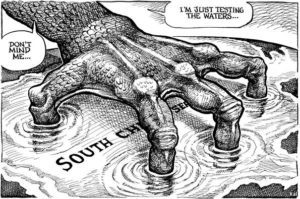CHINA INVADE TAIWAN? | Hawaii troops playing big role in exercises with Philippines
.
.
Apr. 17—The United States and the Philippines officially kicked off their largest joint military exercise in recent history last week amid boiling regional tensions, and Hawaii troops are playing a central role.
The United States and the Philippines officially kicked off their largest joint military exercise in recent history last week amid boiling regional tensions, and Hawaii troops are playing a central role.
Exercise Balikatan 2023 has a combined 17, 500 troops from the Philippine armed forces, the U.S. military and a small number of Australian troops. It comes after the United States and the Philippines signed new basing agreements that would allow American forces to expand training and operations in the archipelago nation.
“For the Armed Forces of the Philippines, in particular, this year’s Balikatan Exercise is most timely, ” Philippine military’s chief of staff Gen. Andres Centino said Tuesday in a news release, noting his country’s efforts to revamp how its military operates.
The exercise will run through the month and include ground, air and naval forces practicing amphibious operations, urban operations, cyber defense, counterterrorism and other operations.
Members of the U.S. Army’s Schofield-based 25th Infantry Division participating in Balikatan have already been on the ground since March 13, first participating in Exercise Salaknib with Philippine troops, which wrapped up on April 4. The 25th calls itself “America’s Pacific Division ” and has been sending troops around the region and hosting foreign troops in Hawaii for training more frequently through U.S. Army Pacific’s Operation Pathways.
Col. Graham White, commander of the 25th’s 2nd Infantry Brigade Combat Team, told the Star-Advertiser in a video call from the Philippines that joint training between the two countries this year is “certainly bigger and better, and it’s enhanced in every conceivable way.”
.
Lt. Col. Ryan Case, commander of the 2nd Brigade’s 1-27 Infantry Battalion, said that in the Philippines “we’ve been looking at not just the technical aspect of ‘what your weapons do, what our weapons do, what your radios do, what our range is, ‘ and moving more into the procedural interoperability of how we do things and how we will conduct operations with them in the future.”
But interest in new technology—and how it’s changing the battlefield—was still on display during Salaknib. Case said Philippine commanders and troops were particularly interested in looking at how to counter and neutralize drones. Various drone systems both large and small have played a key role in the bloody fighting in Ukraine, introducing new tactical challenges for both invading Russian forces and defending Ukrainian fighters.
“(Philippine troops ) are very, very interested in our training and the systems that we have, ” Case said. “I believe that they’re watching the news and see what’s going on in Europe and seeing how they can incorporate it to the training.”
The Army has been adjusting its strategy for what operating in the vast blue expanse of the Pacific region means for its land-based forces. White said that “really, every exercise, every deployment, is an experimental opportunity for us. And we’re absolutely trying to capitalize on that opportunity while we’re here in the Philippines.”
The Marine Corps’ Kaneohe-based 3rd Marine Littoral Regiment, which officially activated in 2022 and made its overseas debut at last year’s Balikatan, also has troops participating in this year’s iteration as the Marines hone their own new Pacific strategy.
The 3rd MLR, which is ultimately intended to serve as the blueprint for a major reorganization of the Marine Corps as a whole, is geared toward coastal and island operations as the Corps looks to put its experiences with bloody drawn-out counterinsurgency operations in Iraq and Afghanistan in its rearview mirror.
The new Corps envisions Marines returning to their naval roots conducting the sorts of “island hopping ” missions they did during World War II, but with a 21st-century twist. Service leaders envision relatively small groups of Marines operating spread out across islands and the ocean, setting up missile batteries to sink enemy ships.
A key part of making that work is coordinating with regional countries such as the Philippines. During Balikatan 2022 the MLR teamed up with Philippine troops to practice joint amphibious landings on northern Luzon island and coastal defense operations. Officials said that this year in western Palawan province, troops will practice retaking an island captured by enemy forces.
.
The Marine Corps makeover is largely tailored for operations in the Western Pacific, where China has been embroiled in a series of disputes with the Philippines and other neighboring countries over territorial and navigation rights in the South China Sea, a critical waterway that more than a third of all international trade moves through.
Beijing considers the entire sea its exclusive territory and has built bases on disputed islands and reefs to assert its claims.
In particular, the Philippines and China have sparred over the disputed Spratly Islands. In 2016 an international court ruled in the Philippines’ favor and declared that Beijing’s territorial claim had “no legal basis.” But the Chinese military has continued to build bases and has regularly harassed and attacked Filipino fishermen—driving many from their traditional fishing grounds.
Some analysts think the Spratlys could become strategically important during a potential Chinese invasion of Taiwan, a self-ruled island that China considers a rogue province.
The Philippines’ new president, Ferdinand Marcos Jr.—son of dictator Ferdinand Marcos, who died in exile in Honolulu after his overthrow—ran for office on a platform that included trying to improve relations with Beijing. Before taking office in 2022, Marcos said he would continue many of the policies of his controversial predecessor, Rodrigo Duterte, who also sought closer ties with China.
Marcos touted his friendship with Chinese officials and suggested he would be willing to set aside the 2016 ruling to pursue a new agreement with China. But continued harassment of Filipino fishermen and other mariners by Chinese vessels has fueled increasing anti-Chinese sentiment in the Philippines.
Continued Chinese military operations in the West Philippine Sea—the parts of the South China Sea that the Philippines considers its sovereign territory—and accompanying frustration in the Philippines have pushed Marcos and his administration to take a much tougher stance on China as it now seeks closer cooperation with the United States, Japan and other countries.
.
In March, Marcos told reporters that the expanded basing agreement announced in February would see operations by U.S. troops “scattered around the Philippines—there are some in the north, there are some around Palawan, there are some further south.”
White said that U.S. military engineers have been working this year on a series of infrastructure projects at Philippine military bases to improve their facilities.
“Those are ongoing ; our partners appreciate those, ” White said, adding that they are “in conjunction with our partners, so there’s Philippine engineers alongside us.”
But while many in the Philippines have welcomed a tougher stance on Chinese forces’ ongoing operations in their waters, others have expressed concerns about the potential of U.S. troops making more frequent visits to their country.
Manuel Mamba, governor of the northern coastal province Cagayan—which is just 300 miles south of Taiwan—told the Manilla Standard in February that for him “any foreign forces are not welcome here. … I am not pro-China nor pro-America ; rather, I am pro-Cagayan and do what is best for the populace of the province, and I am for our country.”
The National Federation of Small Fisherfolk Organizations in the Philippines said in a February Twitter post that “our territorial waters in the West Philippine Sea are already militarized by China ; the last thing that Fili pino fishers want is an expansion of U.S. military bases at the further expense of our sovereign rights and territorial integrity.”
This week the group voiced displeasure that the Philippine government will restrict movement in certain areas at sea to allow for maneuvers as part of Bali katan, telling the Philippine Daily Inquirer that “the immediate impact of a day without fishing for the fishers and their families cannot be equated to whatever benefit may be gained from the military exercises ” and that “the concerns of many sectors and patriotic individuals are legitimate that the Philippines might be caught in the crossfire of the power struggle between the U.S. and China.”
.
Regional leaders across the Pacific have called on the United States and China to lower the temperature on tensions. But remarks by diplomats from the two countries have been barbed. U.S. military officials in the Pacific say the Chinese military has not responded to attempts to reestablish lines of communication they once maintained to avoid conflict. Meanwhile, China has accused the United States of provocation as it continues to seek closer ties with countries around the region.
On Wednesday, Chinese Foreign Ministry spokesperson Wang Wenbin said in a statement issued through China’s Manilla embassy that joint exercises between the United States and the Philippines “should not target any third party and should be conducive to regional peace and stability.”
.


 Memento Maxima Digital Marketing
Memento Maxima Digital Marketing Ads by: Memento Maxima Digital Marketing
Ads by: Memento Maxima Digital Marketing






